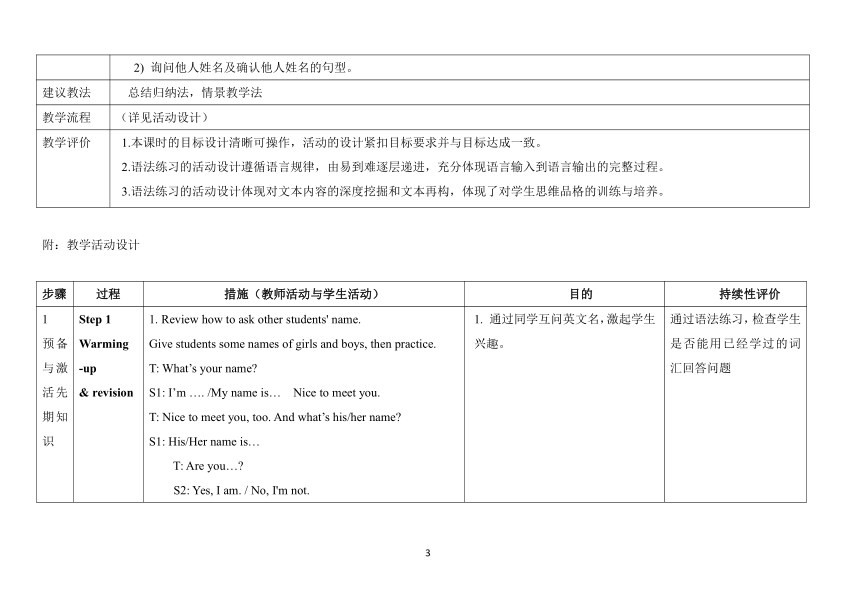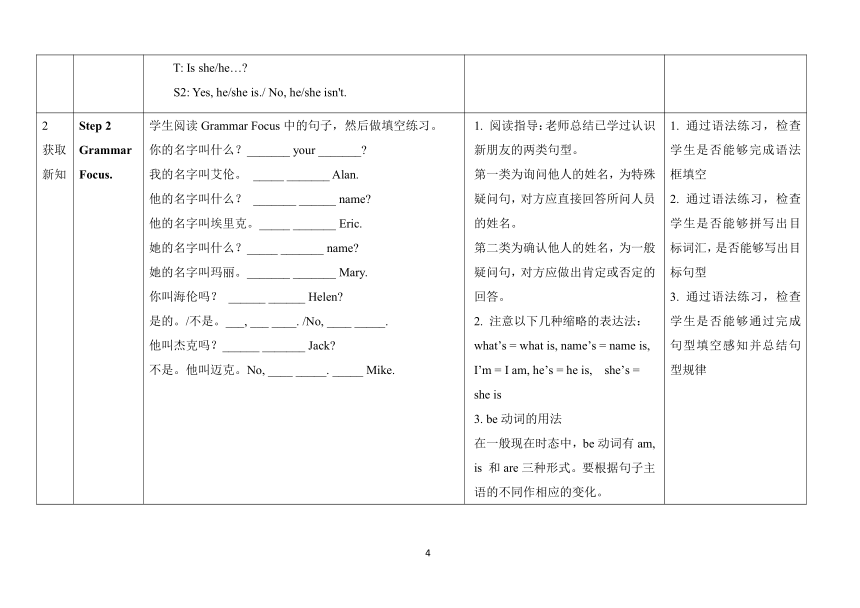Unit 1 My name’s Gina SectionA(Grammar Focus-3c)表格式教案
文档属性
| 名称 | Unit 1 My name’s Gina SectionA(Grammar Focus-3c)表格式教案 |  | |
| 格式 | zip | ||
| 文件大小 | 11.0KB | ||
| 资源类型 | 教案 | ||
| 版本资源 | 人教新目标(Go for it)版 | ||
| 科目 | 英语 | ||
| 更新时间 | 2019-10-17 21:13:50 | ||
图片预览




文档简介
Unit 1 My name’s Gina Section A(Grammar Focus-3c) 教案
【教材版本与册数】新目标人教版七年级上册
【单元名称】 Unit 1 My name’s Gina.
【课时】Section A Grammar Focus-3c (第3课时)
【课型】Grammar(语法课)
教材分析
【本单元话题】
本单元围绕“结交新朋友”使学生学会打招呼和介绍自己、询问他人姓名。
【本单元重点掌握目标】
主要学习学会打招呼和介绍自己、询问他人姓名“What’s your/his/her name?My/His/Her name is…”;
学习区分"First/last name”,了解有关姓名的文化知识;
学习查询电话号码“What’s your/her/his phone number?”;
学习数字1~9。
【教材内容分析】
Section A要求学生掌握各形容词性物主代词,并学会使用重点句型询问人名
【通过本单元的学习学生需掌握哪些综合技能】
通过本单元的学习使学生学会谈论自己喜好的学科或自己喜好的其它事情并给出理由;学会说出一周的七天;学会合理地安排自己的作息时间。
教学目标
1. 语言知识目标:
1) 继续练习运用如何做自我介绍及问候他人。学会从对话中获取对方的基本信息(询问他人姓名)。 能掌握以下句型:
① —What’s your/his/her name?
—My/his her name is…
② —Are you…?
—Yes, I am. / No, I'm not.
③ —Is he/she…?
—Yes, she/he is. / No, she/he isn’t.
2) 能了解以下语法:your, his, her等形容词性物主代词的简单用法;掌握what’s, name’s, I’m, he’s, she’s等缩写形式。
2. 情感态度价值观目标:
该部分学习侧重提高学生们的实践运用能力的提高,内容仍贴近学生的生活,谈论的主题是结交新朋友,询问及确认他人的姓名。进一步促进学生之间的相互了解,使学生在轻松、愉快的学习氛围中熟识新伙伴,增进友谊。通过教学使学生对英语产生强烈的兴趣和愿望,乐于参加各种语言实践活动。能与伙伴团结一致、友好相处,学会如何礼貌地与他人交往。
教学重难点
1. 教学重点:
1) 让学生学会自我介绍,正确使用问候语,学会交朋友。
2) 会运用所学的句型询问第三者的姓名。
3) 会运用所学的句型确认第三者的姓名。
2. 教学难点:
1) your, his, her等形容词性物主代词的简单用法;
2) 询问他人姓名及确认他人姓名的句型。
建议教法
总结归纳法,情景教学法
教学流程
(详见活动设计)
教学评价
本课时的目标设计清晰可操作,活动的设计紧扣目标要求并与目标达成一致。
2.语法练习的活动设计遵循语言规律,由易到难逐层递进,充分体现语言输入到语言输出的完整过程。
3.语法练习的活动设计体现对文本内容的深度挖掘和文本再构,体现了对学生思维品格的训练与培养。
附:教学活动设计
步骤
过程
措施(教师活动与学生活动)
目的
持续性评价
1
预备与激活先期知识
Step 1
Warming
-up
& revision
1. Review how to ask other students' name.
Give students some names of girls and boys, then practice.
T: What’s your name?
S1: I’m …. /My name is… Nice to meet you.
T: Nice to meet you, too. And what’s his/her name?
S1: His/Her name is…
T: Are you…?
S2: Yes, I am. / No, I'm not.
T: Is she/he…?
S2: Yes, he/she is./ No, he/she isn't.
1. 通过同学互问英文名,激起学生兴趣。
通过语法练习,检查学生是否能用已经学过的词汇回答问题
2
获取新知
Step 2
Grammar Focus.
学生阅读Grammar Focus中的句子,然后做填空练习。
你的名字叫什么?_______ your _______?
我的名字叫艾伦。 _____ _______ Alan.
他的名字叫什么? _______ ______ name?
他的名字叫埃里克。_____ _______ Eric.
她的名字叫什么?_____ _______ name?
她的名字叫玛丽。_______ _______ Mary.
你叫海伦吗? ______ ______ Helen?
是的。/不是。___, ___ ____. /No, ____ _____.
他叫杰克吗?______ _______ Jack?
不是。他叫迈克。No, ____ _____. _____ Mike.
1. 阅读指导:老师总结已学过认识新朋友的两类句型。
第一类为询问他人的姓名,为特殊疑问句,对方应直接回答所问人员的姓名。
第二类为确认他人的姓名,为一般疑问句,对方应做出肯定或否定的回答。
2. 注意以下几种缩略的表达法:what’s = what is, name’s = name is, I’m = I am, he’s = he is, she’s = she is
3. be动词的用法
在一般现在时态中,be动词有am, is 和are三种形式。要根据句子主语的不同作相应的变化。
4. 人称代词和物主代词
“我” I; “你” you; “他” he; “她” she; “它” it; “你们” you; “我们” we; “他们”they 称为人称代词,在句子中作主语。
1. 通过语法练习,检查学生是否能够完成语法框填空
2. 通过语法练习,检查学生是否能够拼写出目标词汇,是否能够写出目标句型
3. 通过语法练习,检查学生是否能够通过完成句型填空感知并总结句型规律
3
深度加工知识
Step 3
Practice I
Work on 3a.
1. Look at 3a. Tell Ss to put the words in order to make conversations. Pay attention to the right sentence structure. Ss work with their partners. Try to make conversations with the given words.
2. Check the answers. Encourage some pairs to act out the dialogue. See if their dialogues are right.
3. Ss read the dialogue aloud after the teacher. Then try to practice the dialogues with their partners.
4. Let some pairs to act out the dialogue in front of the class.
1. 通过调整词序组成对话练习,从所提供的单词中捕捉可能的语境信息,达到语言输入的目的。
2. 在练习中区别形容词性物主代词与人称代词。
3. 通过提示词yes和no,完成一般疑问句的肯否回答。
1. 通过语法练习,检查学生是否能运用目标词汇与基本句型
2. 通过语法练习,检查学生是否能用目标词汇回答问题
Step 4
Practice II
Work on 3b.
1. Look at 3b. Tell Ss to complete the conversation. Pay attention to the right sentence structure. Ss work with their partners. Try to make conversation.
2. Check the answers. Encourage some pairs to act out the conversations. See if their answers are right.
3. Ss read the conversations aloud after the teacher. Then try to practice the conversations with their partners.
4. Let some pairs to act out the conversations in front of the class.
1. 通过把握对话所给的语境,联系上下文语境推测、判断应填写的内容。
2. 通过听力,练习书写规范,避免将首字母大写错写为小写的问题。
1. 通过语境练习,检查学生是否能运用目标词汇与基本句型
2. 通过语境练习,检查学生是否能通过上下文语境推测、判断应填写的内容
4
评价学生的学习
Step 5
Game
Work on 3c.
1. Now, each of you has an English name. So we have learnt many names about boys and girls. Do you know how many foreign names? Let's do a "Name game".
Competition: list names as many as possible, see which group gets the most names.
2. Divide the Ss into groups of six or more. Each group has four or six students.
3. Tell Ss how to play the game. Make a model for the Ss.
S1: My name is Jenny.
S2: Her name is Jenny. My name is Tony.
S3: Her name is Jenny. His name is Tony…My name is June.
S4: …
4. Ss play the game in their groups first. Then have a competition. See which group is the best.
评价:让学生们对自己的表现及语言表达能力进行自我评价,在小组内评价,然后进行评出最优秀的小组。并鼓励学生们下一次争取做最优秀的小组及个人。
通过游戏,检查学生是否能够利用所学目标词语及句型创编新的对话。
Step 6
Exercises
1. If time is enough, let the students do more exercises.
2. Do the workbook.
Step 7
Summary
1. —What’s your/his/her name?
—My/his her name is…
2. —Are you…?
—Yes, I am. / No, I'm not.
3. —Is he/she…?
—Yes, she/he is. / No, she/he isn’t.
总结巩固课时所学内容
Step 8
Homework
前一节课上, 老师问了你的姓名, 并向你问了小组其他成员姓名。记录这一对话。
巩固所学词汇及句型
学生是否能够通过所学完成家庭作业
【教材版本与册数】新目标人教版七年级上册
【单元名称】 Unit 1 My name’s Gina.
【课时】Section A Grammar Focus-3c (第3课时)
【课型】Grammar(语法课)
教材分析
【本单元话题】
本单元围绕“结交新朋友”使学生学会打招呼和介绍自己、询问他人姓名。
【本单元重点掌握目标】
主要学习学会打招呼和介绍自己、询问他人姓名“What’s your/his/her name?My/His/Her name is…”;
学习区分"First/last name”,了解有关姓名的文化知识;
学习查询电话号码“What’s your/her/his phone number?”;
学习数字1~9。
【教材内容分析】
Section A要求学生掌握各形容词性物主代词,并学会使用重点句型询问人名
【通过本单元的学习学生需掌握哪些综合技能】
通过本单元的学习使学生学会谈论自己喜好的学科或自己喜好的其它事情并给出理由;学会说出一周的七天;学会合理地安排自己的作息时间。
教学目标
1. 语言知识目标:
1) 继续练习运用如何做自我介绍及问候他人。学会从对话中获取对方的基本信息(询问他人姓名)。 能掌握以下句型:
① —What’s your/his/her name?
—My/his her name is…
② —Are you…?
—Yes, I am. / No, I'm not.
③ —Is he/she…?
—Yes, she/he is. / No, she/he isn’t.
2) 能了解以下语法:your, his, her等形容词性物主代词的简单用法;掌握what’s, name’s, I’m, he’s, she’s等缩写形式。
2. 情感态度价值观目标:
该部分学习侧重提高学生们的实践运用能力的提高,内容仍贴近学生的生活,谈论的主题是结交新朋友,询问及确认他人的姓名。进一步促进学生之间的相互了解,使学生在轻松、愉快的学习氛围中熟识新伙伴,增进友谊。通过教学使学生对英语产生强烈的兴趣和愿望,乐于参加各种语言实践活动。能与伙伴团结一致、友好相处,学会如何礼貌地与他人交往。
教学重难点
1. 教学重点:
1) 让学生学会自我介绍,正确使用问候语,学会交朋友。
2) 会运用所学的句型询问第三者的姓名。
3) 会运用所学的句型确认第三者的姓名。
2. 教学难点:
1) your, his, her等形容词性物主代词的简单用法;
2) 询问他人姓名及确认他人姓名的句型。
建议教法
总结归纳法,情景教学法
教学流程
(详见活动设计)
教学评价
本课时的目标设计清晰可操作,活动的设计紧扣目标要求并与目标达成一致。
2.语法练习的活动设计遵循语言规律,由易到难逐层递进,充分体现语言输入到语言输出的完整过程。
3.语法练习的活动设计体现对文本内容的深度挖掘和文本再构,体现了对学生思维品格的训练与培养。
附:教学活动设计
步骤
过程
措施(教师活动与学生活动)
目的
持续性评价
1
预备与激活先期知识
Step 1
Warming
-up
& revision
1. Review how to ask other students' name.
Give students some names of girls and boys, then practice.
T: What’s your name?
S1: I’m …. /My name is… Nice to meet you.
T: Nice to meet you, too. And what’s his/her name?
S1: His/Her name is…
T: Are you…?
S2: Yes, I am. / No, I'm not.
T: Is she/he…?
S2: Yes, he/she is./ No, he/she isn't.
1. 通过同学互问英文名,激起学生兴趣。
通过语法练习,检查学生是否能用已经学过的词汇回答问题
2
获取新知
Step 2
Grammar Focus.
学生阅读Grammar Focus中的句子,然后做填空练习。
你的名字叫什么?_______ your _______?
我的名字叫艾伦。 _____ _______ Alan.
他的名字叫什么? _______ ______ name?
他的名字叫埃里克。_____ _______ Eric.
她的名字叫什么?_____ _______ name?
她的名字叫玛丽。_______ _______ Mary.
你叫海伦吗? ______ ______ Helen?
是的。/不是。___, ___ ____. /No, ____ _____.
他叫杰克吗?______ _______ Jack?
不是。他叫迈克。No, ____ _____. _____ Mike.
1. 阅读指导:老师总结已学过认识新朋友的两类句型。
第一类为询问他人的姓名,为特殊疑问句,对方应直接回答所问人员的姓名。
第二类为确认他人的姓名,为一般疑问句,对方应做出肯定或否定的回答。
2. 注意以下几种缩略的表达法:what’s = what is, name’s = name is, I’m = I am, he’s = he is, she’s = she is
3. be动词的用法
在一般现在时态中,be动词有am, is 和are三种形式。要根据句子主语的不同作相应的变化。
4. 人称代词和物主代词
“我” I; “你” you; “他” he; “她” she; “它” it; “你们” you; “我们” we; “他们”they 称为人称代词,在句子中作主语。
1. 通过语法练习,检查学生是否能够完成语法框填空
2. 通过语法练习,检查学生是否能够拼写出目标词汇,是否能够写出目标句型
3. 通过语法练习,检查学生是否能够通过完成句型填空感知并总结句型规律
3
深度加工知识
Step 3
Practice I
Work on 3a.
1. Look at 3a. Tell Ss to put the words in order to make conversations. Pay attention to the right sentence structure. Ss work with their partners. Try to make conversations with the given words.
2. Check the answers. Encourage some pairs to act out the dialogue. See if their dialogues are right.
3. Ss read the dialogue aloud after the teacher. Then try to practice the dialogues with their partners.
4. Let some pairs to act out the dialogue in front of the class.
1. 通过调整词序组成对话练习,从所提供的单词中捕捉可能的语境信息,达到语言输入的目的。
2. 在练习中区别形容词性物主代词与人称代词。
3. 通过提示词yes和no,完成一般疑问句的肯否回答。
1. 通过语法练习,检查学生是否能运用目标词汇与基本句型
2. 通过语法练习,检查学生是否能用目标词汇回答问题
Step 4
Practice II
Work on 3b.
1. Look at 3b. Tell Ss to complete the conversation. Pay attention to the right sentence structure. Ss work with their partners. Try to make conversation.
2. Check the answers. Encourage some pairs to act out the conversations. See if their answers are right.
3. Ss read the conversations aloud after the teacher. Then try to practice the conversations with their partners.
4. Let some pairs to act out the conversations in front of the class.
1. 通过把握对话所给的语境,联系上下文语境推测、判断应填写的内容。
2. 通过听力,练习书写规范,避免将首字母大写错写为小写的问题。
1. 通过语境练习,检查学生是否能运用目标词汇与基本句型
2. 通过语境练习,检查学生是否能通过上下文语境推测、判断应填写的内容
4
评价学生的学习
Step 5
Game
Work on 3c.
1. Now, each of you has an English name. So we have learnt many names about boys and girls. Do you know how many foreign names? Let's do a "Name game".
Competition: list names as many as possible, see which group gets the most names.
2. Divide the Ss into groups of six or more. Each group has four or six students.
3. Tell Ss how to play the game. Make a model for the Ss.
S1: My name is Jenny.
S2: Her name is Jenny. My name is Tony.
S3: Her name is Jenny. His name is Tony…My name is June.
S4: …
4. Ss play the game in their groups first. Then have a competition. See which group is the best.
评价:让学生们对自己的表现及语言表达能力进行自我评价,在小组内评价,然后进行评出最优秀的小组。并鼓励学生们下一次争取做最优秀的小组及个人。
通过游戏,检查学生是否能够利用所学目标词语及句型创编新的对话。
Step 6
Exercises
1. If time is enough, let the students do more exercises.
2. Do the workbook.
Step 7
Summary
1. —What’s your/his/her name?
—My/his her name is…
2. —Are you…?
—Yes, I am. / No, I'm not.
3. —Is he/she…?
—Yes, she/he is. / No, she/he isn’t.
总结巩固课时所学内容
Step 8
Homework
前一节课上, 老师问了你的姓名, 并向你问了小组其他成员姓名。记录这一对话。
巩固所学词汇及句型
学生是否能够通过所学完成家庭作业
同课章节目录
- starters 预备篇(2012秋审查)
- Unit 1 Good morning !
- Unit 2 What’s this in English?
- Unit 3 What color is it ?
- Unit 1 My name's Gina.
- Section A
- Section B
- Unit 2 This is my sister.
- Section A
- Section B
- Unit 3 Is this your pencil?
- Section A
- Section B
- Unit 4 Where's my schoolbag?
- Section A
- Section B
- Unit 5 Do you have a soccer ball?
- Section A
- Section B
- Unit 6 Do you like bananas?
- Section A
- Section B
- Unit 7 How much are these socks?
- Section A
- Section B
- Unit 8 When is your birthday?
- Section A
- Section B
- Unit 9 My favorite subject is science.
- Section A
- Section B
